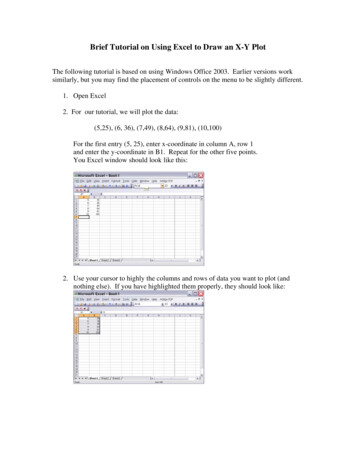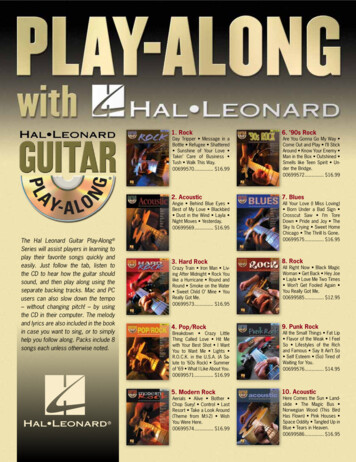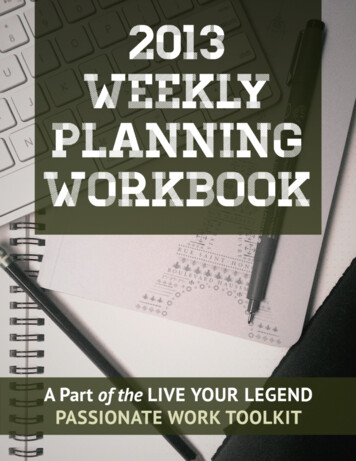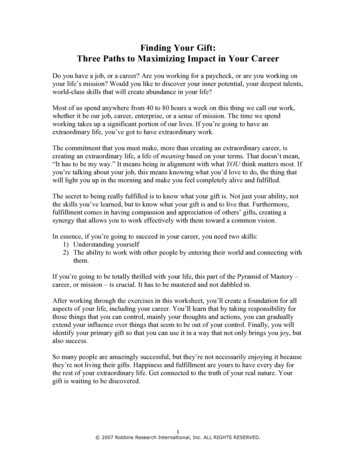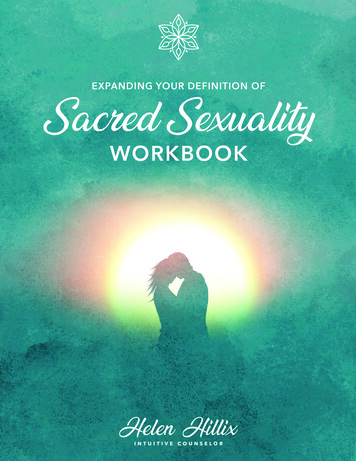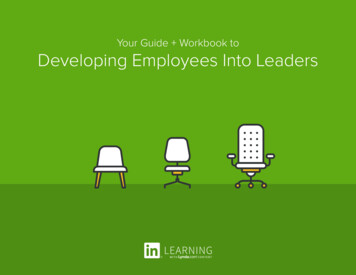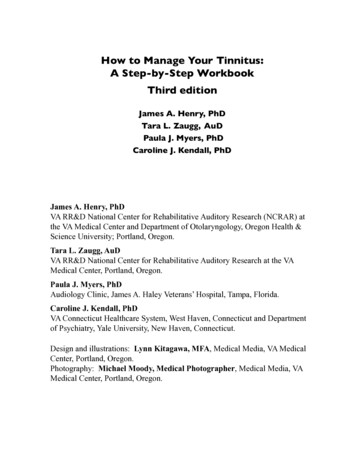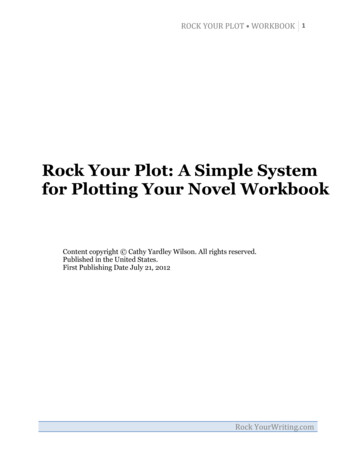
Transcription
ROCK YOUR PLOT WORKBOOK 1Rock Your Plot: A Simple Systemfor Plotting Your Novel WorkbookContent copyright Cathy Yardley Wilson. All rights reserved.Published in the United States.First Publishing Date July 21, 2012Rock YourWriting.com
ROCK YOUR PLOT WORKBOOK 2Table of ContentsIntroductionPart I Create the BackgroundChapter 1: Test Your IdeaChapter 2: Goal, Motivation, ConflictChapter 3: Character SketchesChapter 4: Overview of the Plot PointsChapter 5: The Opening, a.k.a. "The Inciting Incident"Chapter 6: Plot Point 1Chapter 7: Midpoint, a.k.a. Plot Point 2Chapter 8: Plot Point 3Chapter 9: Black MomentChapter 10: ResolutionChapter 11: Pinch PointsPart II Create the Scene OutlineConclusionRock YourWriting.com
ROCK YOUR PLOT WORKBOOK 3INTRODUCTIONWhat this book covers:This workbook will walk you through assignments that will get you from vague storyidea to completed rough draft, covering the following steps:— Testing your premise for inherent conflict and sustainability— Goal, motivation, conflict— Character sketches.— Plot Points— Scene OutlineFor each step, follow the assignments to help you put the principles into practice in yourown novel.Rock YourWriting.com
ROCK YOUR PLOT WORKBOOK 4CHAPTER 1: TEST YOUR IDEAThe premise is a fundamental concept that drives the plot. It helps identify theprotagonist, and should state your story goal.1. What is your premise?One sentence, if possible.2. Check your sentences for the principles of high concept, using the followingfield test questions:Is there something noticeably different from what’s usually in the genre? ( )Is there an element of universal appeal? ( )Is there an emotional appeal? ( )Is there visual appeal? ( )Can it be easily reduced to one sentence? ( )3. Do you have at least one main character who wants something? ( )4. Is something significant standing in the way of his achieving the goal? ( )Rock YourWriting.com
ROCK YOUR PLOT WORKBOOK 55. What is your target market?Manuscript Project Target: words6. Why do you want to write this book? What appeals to you about it?7. Do you have a message or a theme you want to explore with this book? ( )Rock YourWriting.com
ROCK YOUR PLOT WORKBOOK 6CHAPTER 2: GOAL – MOTIVATION- CONFLICTThe key to all plotting is in what is commonly referred to as the GMC – the Goal,Motivation, and Conflict for your characters. Essentially, you want to work on the assumptionthat your character has two driving desires: an internal goal, and an external goal.External GoalThe external goal is going to be your story question, in terms of the protagonist.Internal GoalThe internal goal deals with feelings and emotions, and by its very nature is notquantifiable.MotivationThe goal has to be important to the protagonist in ways that the reader will understand.Motivation is the key for setting that up.ConflictOnce you’ve set that hook, you’re going to do everything in your power to preventyour character to get there.So how do you do that? Here are some pointers:1. The conflict should be related to the goal.2. The conflict must escalate.3. Think of the worst possible thing that could happen to yourcharacter, again in terms of the story goal.Rock YourWriting.com
ROCK YOUR PLOT WORKBOOK 7ASSIGNMENT:I External Goals1.Write the external goal for your main protagonist.2.Write the motivation for the external goal.Rock YourWriting.com
ROCK YOUR PLOT WORKBOOK 83.Write the conflict for the external goal.II Internal GoalsRepeat for the internal goal, motivation and conflict.1.Write the internal goal for your main protagonist.Rock YourWriting.com
ROCK YOUR PLOT WORKBOOK 92.Write the motivation for the internal goal.3.Write the conflict for the internal goal.Rock YourWriting.com
ROCK YOUR PLOT WORKBOOK 10Repeat all steps for any major character, especially an antagonist if applicable.Print the charts below to use for an overview for your characters.QUICK CHART for OTIVATIONCONFLICTQUICK CHART for OTIVATIONCONFLICTRock YourWriting.com
ROCK YOUR PLOT WORKBOOK 11CHAPTER 3: CHARACTER SKETCHESCreating Compelling Main CharactersMy character method:1. Start with a sketch.2. Write an exploratory biography.3. Are you having trouble getting a grip on the character? Then interview thecharacter to hear his or her “voice.”How many sketches, and which characters?Do the character work for any major characters.ASSIGNMENT:1. Describe your character.Rock YourWriting.com
ROCK YOUR PLOT WORKBOOK 122. Using the character’s age as a starting point, write a life history of your character,keeping the GMC and your premise in mind.3. If you like, write either a page or two in the first person POV of your character, or―interview‖ your character, to get a sense of his/her beliefs and how he/she is ―entering‖ thestory.Rock YourWriting.com
ROCK YOUR PLOT WORKBOOK 13CHAPTER 4: OVERVIEW OF THE PLOT POINTSThe Plot PointsAfter the GMC charts and background character sketches, the next step is figuring outthe plot points. They are the guideposts to get you from beginning to the end of your novel.These are the plot points. Space provided is for brief notes:1.The Inciting Incident: the moment something changes.2.Plot Point 1: establishing the story question.3.Pinch Point 1: Opposition shows itself.4.Midpoint/Plot Point 2: new information shifts protagonist from reactive to proactive.5.Pinch Point 2: the antagonist strikes back.6.Plot Point 3: ramp up for third act.7.Black Moment: worst thing ever (in terms of story question.)8.Resolution.Rock YourWriting.com
ROCK YOUR PLOT WORKBOOK 14CHAPTER 5: THE OPENING, A.K.A. "THE INCITING INCIDENT"Your inciting incident should have a hook, something intriguing, a puzzle or anoutrageous character or, my personal favorite, something that makes the reader want to findout what’s going on.ASSIGNMENT:Write down your inciting incident.What’s the “something different” that is going to start to push your protagonisttowards an inevitable change?Rock YourWriting.com
ROCK YOUR PLOT WORKBOOK 15CHAPTER 6: PLOT POINT 1This is the end of the first act, and the gateway to the vast wilderness that is The Middle.At this plot point, you firmly establish the story question, as well as giving the motivation whyyour protagonist wants her goal and what the (dire) consequence is if she tries to avoid it.Plot Point 1 is the point of no return.What the first plot point shows.The Plot Point 1 is where your character knows what he or she needs to do, and hasabsolutely no frickin’ clue how to go about that. Usually, a sense of panic and headless-chickenrunning-around ensues in my stories, at least!ASSIGNMENT:Write down your first plot point. basically, your GMC, in one scene that illustrateswhy it’s important and how serious the conflict is.Rock YourWriting.com
ROCK YOUR PLOT WORKBOOK 16CHAPTER 7: THE MIDPOINT, A.K.A. PLOT POINT 2Plot Point 2, also known as ―the Midpoint,‖ is when your protagonist figures out whatshe needs to do.This proactive quality is usually the best way to define a midpoint, in my opinion.The midpoint is also an escalation.New information is introduced.Choices are made.The protagonist's options are pruned. When he gets to the inevitable climax, you wantthe reader to feel that, given the character he is and the choices he’s made, he has no otherreasonable option.The Black Moment needs to have a ring of inevitability—like a train wreck you can’t lookaway from. To do that, he’s got to burn some bridges.ASSIGNMENT:Write a brief description of your midpoint.Use your GMC charts, and write what your character has learned and what his actiontowards achieving the goal is going to be. Also, check to see if the conflict is greater now thanit was in plot point 1. What has escalated?Rock YourWriting.com
ROCK YOUR PLOT WORKBOOK 17CHAPTER 8: PLOT POINT 3The third plot point is the calm before the storm of the third act: like the ―click-clickclick‖ of a roller coaster, just before the plunge.Similar to the midpoint, this usually also has a new information aspect to it. In fact, thisshould be the last big reveal, and the thing that sets up your last act. What the reader andprotagonist learn at this plot point should set the protagonist up for the big dramaticconclusion.No new information after this point.Figure out this point last.I always write the third plot point after I write the Black Moment and Resolutionpoints. Why? Because then I’ll know what information needs to be set up by this point, and I’llknow what would be the most devastating lead in to the Black Moment will be.ASSIGNMENT:Write down a brief description of your third plot point. I’d suggest saving this for afterthe Black Moment and resolution.Rock YourWriting.com
ROCK YOUR PLOT WORKBOOK 18CHAPTER 9:BLACK MOMENTThe Black Moment, which some writers call the climax, should be one of the easiest plotpoints to nail down. (The only one that might be easier would be Plot Point 1, because if youdon’t know that, you don’t know your story question.)If you know the first plot point, then your question to arrive at the Black Moment is:What is the absolute worst thing that can happen in terms of his goal?External or Internal?Now, note that this can be your internal or external story goal.Develop internal conflict by forcing the protagonist make a tough choice, one at theexpense of the other: in order to achieve the external goal.Go for the soul-crush.ASSIGNMENT:Write down a soul-crushing Black Moment. Make sure that it ties in to the character’sGMC, either internal, external, or both.Rock YourWriting.com
ROCK YOUR PLOT WORKBOOK 19Chapter 10: RESOLUTIONThe tricky part about really disastrous Black Moments? Figuring a way out of them.How to resolve a soul-crushing Black Moment.First, brainstorm.Keep an open mind. You might not get the answer you’re looking for, but your brain willprobably click into an answer trying to defend whatever it is your subconscious wants.Second, have faith. Take a little breather, give yourself some space, and believe thatyou’re going to find the solution.ASSIGNMENT:Write down how the story resolves. What is your ending? Does it tie up all loose endsnecessary in this novel?Rock YourWriting.com
ROCK YOUR PLOT WORKBOOK 20CHAPTER 11: PINCH POINTSASSIGNMENT:Write down Pinch Point 1 and Pinch Point two for your novel.Pinch Point #1:Pinch Point #2:Rock YourWriting.com
ROCK YOUR PLOT WORKBOOK 21PART II: CREATING THE OUTLINEBy now, you should have:( ) 1. Your character background (for at least the protagonists)( ) 2. Your character GMC charts (again, for at least the protagonists)( ) 3. Your plot points:( ) —Inciting Incident( ) —Plot Point 1( ) —Pinch Point 1( ) —Midpoint( ) —Pinch Point 2( ) —Plot Point 3( ) —Black Moment( ) —ResolutionASSIGNMENT:Write a scene outline of every scene you think will be in the book.Each scene supports the story as a whole. And if things go wrong, you will have adiagram that shows you why.The System:1. First, pick a word count/page count that fits your target genre.2. Then, pick an arbitrary number of scenes.3. Then, create the empty outline. Blank Scene Outline.4. Pop in the plot points.Rock YourWriting.com
ROCK YOUR PLOT WORKBOOK 22Suggested Novel Breakdown according to Plot ting Incident50.00%Plot Points40.00%Pinch Points30.00%Black Moment20.00%10.00%0.00%First PlotPointMidPointThird PlotPointResolutionOnce you’ve popped in the plot points, you’re not going to try plotting a bookfrom beginning to end – giving you a framework, as well as a clear beginning and end.What each scene note in the outline should contain.You should have the goal-motive-conflict-disaster (or "GMCD") pattern in every scene,and the sequel either at the beginning or at the end of an existing GMCD scene.In my scene outlines, I include the following information:( ) 1. POV. I want to know who the main POV character is, because that’s whose scenegoal I’m looking at.( ) 2. Goal. What does the POV character want?( ) 3. Motivation. Why does the POV character want it so badly? More importantly:how does it relate to the overall story goal, the big GMC?( ) 4. Conflict. What’s standing in the way?( ) 5. Disaster. This is the no, yes-but, or no-and-furthermore. Unless it’s a resolutionscene, every scene is going to end in a disaster.On my website, I will include a full scene outline for one of my old novels, with this levelof detail, just so you can get a sense of how it looks and what’s involved. Sample Scene Outline– Players Club.Rock YourWriting.com
ROCK YOUR PLOT WORKBOOK 23Once your outline is filled in You’re done! You have a full road map, you know where your story goes (in theory) andyou’re ready to rock a quick-and-dirty lightning draft.Adjusting the outline.Once you’re in the draft, you may notice that things change: something that made sensein capsule form suddenly doesn’t work when you write it out.You may realize that you’ve made an error in motivation, or something doesn’t flow, oryou really, really want to add a scene/change a scene/ lose a scene.Look at the outline overall: one change will affect the entire novel. That said, it’s usuallya matter of tweaking, here and there. Little notes to remind yourself, or a few new sticky notes,and you’ll be good to go.And that’s it.Rock YourWriting.com
This workbook will walk you through assignments that will get you from vague story idea to completed rough draft, covering the following steps: — Testing your premise for inherent conflict and sustainability — Goal, motivation, conflict — Character sketches. — Plot Points — Scene Outline For each step, follow the assignments to help you put the principles into practice in your own .File Size: 456KBPage Count: 23
